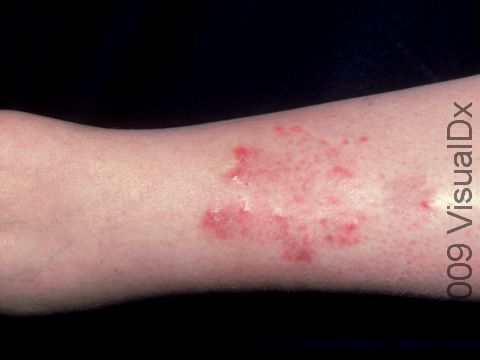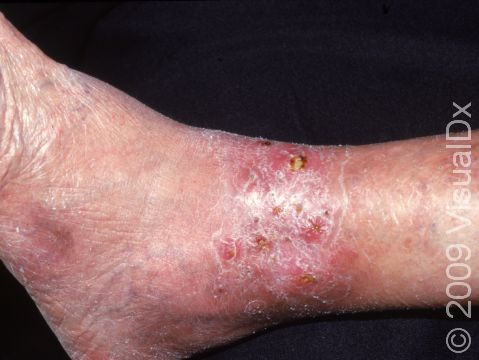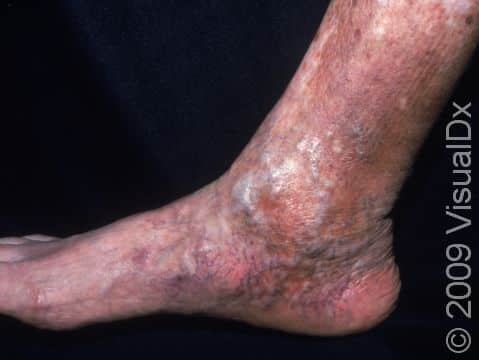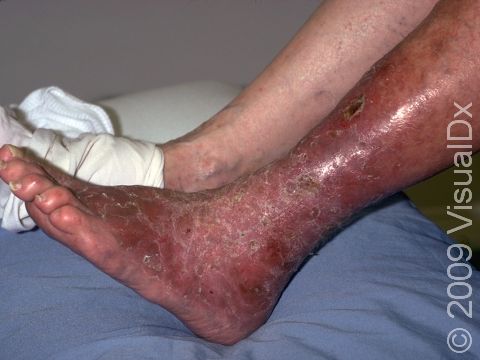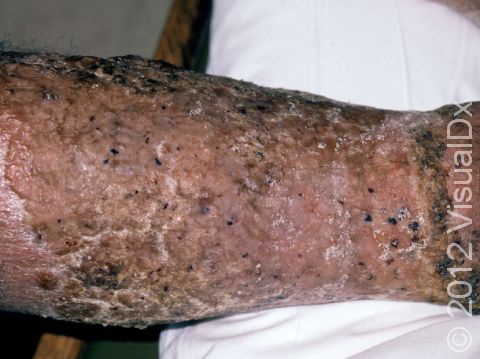Stasis Dermatitis
Dermatitis is a term used to describe irritation of the skin with scaling, rough or dry skin, redness, itching, and sometimes oozing, crusts, and erosions. Stasis is a term used to describe leg swelling seen in conditions of poor circulation and fluid buildup.
Stasis dermatitis is skin irritation and breakdown due to the fluid accumulating under the skin.
Stasis dermatitis can be due to venous insufficiency (vein valve malfunction), heart failure, and other conditions that cause swelling, usually in the legs, but sometimes in other areas as well.
Who's At Risk?
In the US, stasis dermatitis occurs in 6–7% of those over the age 50. The risk of developing stasis dermatitis increases with age. Women are slightly more likely to be affected, perhaps due to the effect of pregnancy on the leg vein system.
When seen in younger people, it is usually due to surgery, trauma, or a history of deep vein blood clots or repeated infections.
Signs & Symptoms
Itching and red, dry areas are usually the first signs of stasis dermatitis. The inside ankle area is often first affected, gradually involving the lower leg up to the knee. The skin may appear shiny or have reddish-brown patches.
Swelling (edema) is usually present, but in chronic cases of stasis dermatitis, there is gradual tightening and scarring of the skin leading to hard and sometimes tender areas.
In severe cases of stasis dermatitis, the skin breaks down with oozing, crusted areas and ulceration. White, shiny scars are often left after healing.
In long-standing cases, there may be significant thickening and darkening of the skin from rubbing.
Self-Care Guidelines
The most important step is to correct the underlying problem causing the fluid buildup. It is also important to understand that the condition is usually a chronic one requiring ongoing care for the rest of one’s life.
If the stasis dermatitis is mild and clearly related to leg swelling, which is minimal upon arising in the morning but worse after a day of standing, simple measures can assist the veins and reduce the chance of progression of the disease, requiring medical care.
These steps include:
- Wearing elastic support hose (worn to at least knee height) should be put on in the morning upon arising. Many non-prescription and attractive styles are available for men and women. Although they are initially tight, discomfort is less as the swelling is controlled.
- Raising the legs above the level of the heart when sitting reduces fluid buildup.
- Applying 1% hydrocortisone cream (available over the counter) to the red, itchy areas twice daily.
- Practicing a proper skin-care routine, which includes using only mild soaps or cleansers and applying a moisturizer (such as petrolatum) after each bath on the legs.
- Avoiding the use of other creams or topical antibiotics, as allergic reactions are common.
Treatments
The doctor will do an exam to determine the cause of the swelling; vein studies may be suggested and, rarely, a culture or skin biopsy may be done. Compression stockings (a specially designed stocking that applies pressure to the leg to prevent fluid from pooling) may be recommended.
Stronger corticosteroid creams may be used for short periods (not prolonged periods, however, due to the possible thinning of the skin from chronic use). Infection may be treated with oral or intravenous antibiotics. Oral medications may be used to control heart failure or reduce the presence of fluid.
Visit Urgency
If the leg swelling does not respond to simple support hose, see the doctor to look for the underlying cause of the swelling. Also seek help if the itchy areas do not improve with self-care.
Evidence of infection includes pain, fever, increased swelling and redness, or open areas accompanied by pus.
Ulcers or sores require medical attention.
Trusted Links
References
Bolognia, Jean L., ed. Dermatology, pp.219-221. New York: Mosby, 2003.
Freedberg, Irwin M., ed. Fitzpatrick’s Dermatology in General Medicine. 6th ed, pp.2337, 2360. New York: McGraw-Hill, 2003.
Last modified on October 10th, 2022 at 7:27 pm

Not sure what to look for?
Try our new Rash and Skin Condition Finder
